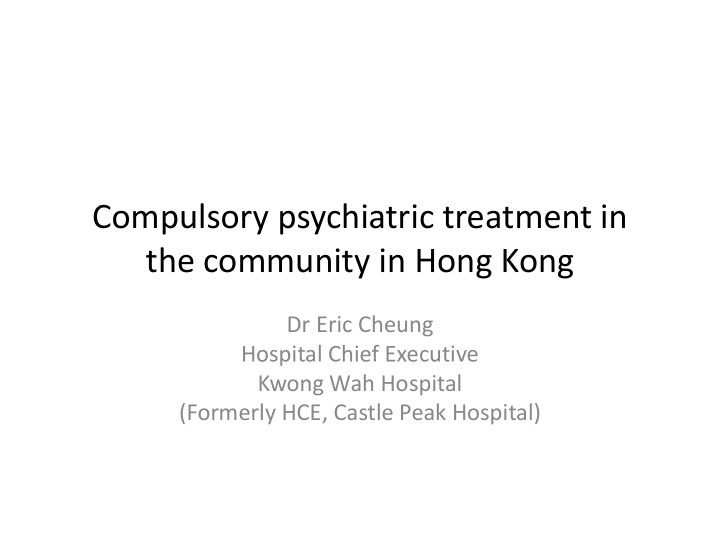



Compulsory psychiatric treatment in the community in Hong Kong Dr Eric Cheung Hospital Chief Executive Kwong Wah Hospital (Formerly HCE, Castle Peak Hospital)
Mental health legislation in Hong Kong • 1906 – Asylums Ordinance • 1950 – Mental Hospitals Ordinance • 1960 – Mental Health Ordinance • 1988 – Mental Health (Amendment) Ordinance • Amendments in 1996, 1997 and 2000
Provisions for compulsory treatment in the community 1. Conditional discharge (Section 42B) 2. Guardianship Order (Part IV) 3. Supervision and Treatment Order (Criminal Ordinance)
Anne Anne Kindergarten • 3 June 1982 stabbing • A 28 year-old man with schizophrenia killed his sister and mother • With 2 eight-inch blades and 2 chisels, he then entered a kindergarten and stabbed 34 children, killing 4 and injuring many others
In essence: • A legal provision that mandates a person with mental illness who meets certain criteria to follow a course of treatment while living in the community, non-compliance of which may result in a recall to inpatient treatment
Conditional discharge (of patients with propensity to violence) • Mental disorder • Medical history of criminal violence or a disposition to commit violence • Must be compulsorily detained under MHO • Enacted by clinicians • Unrelated to mental capacity • Recall if failure to comply with conditions AND necessary to protect self or others • No limit on duration • Appeal via Mental Health Review Tribunal
Designs and features 1. Diversionary vs Preventive 2. Criteria – mental disorder, violence, self- harm, non-compliance, “suitability” 3. Mental capacity 4. Previous hospitalisation 5. Scope of powers – explicit vs calibrated 6. Safeguards and appeal
Evidence on efficacy and effectiveness of CTOs • A contested issue • Inconsistent findings • Difficulty in testing using RCT design • Context-dependent • Little local research or data
Naturalistic pre- and post- studies (Ingram et al, 2009; Muirhead et al, 2006) • Naturalistic mirror-image study in Australia • Retrospective case note review with each case serving as its own control • N = 94 • Results: – Reduced episodes of aggression – Reduced homelessness – Increased service contacts – Reduced admissions and length of inpatient stay
Randomised trials • Three published RCTs: – 2 US studies (Swartz et al, 1999 & Steadman et al, 2001) – 1 UK study (OCTET; Burns et al, 2013) • All used hospital readmission as primary outcome • All three showed no difference in readmission rate
Local research • Wong & Chung (2007) • Retrospective case note review on 12-month outcome of 140 patients on CD • Results: – Psychotic disorders, poor compliance, history of serious dangerous acts – After 12 months: • 10% displayed further violence, 5% forensic contacts, 1% attempted suicide • 25% readmitted – associated with prior admission, younger age, substance misuse
Local application • As at July 2017: – Total number of patients on CD = 1173 – Total number of patients with SMI = 48800 2.5% of patients with SMI
Local application Year Total Compulsory CD Recall admissions admissions 2015 16988 2968 152 23 2014 16752 2804 141 21 2013 17298 2662 162 35 2012 16554 2569 131 16 2011 15336 2371 135 27
Observations • CD is a “unique” provision developed in close relation with the local context • Limited local data seem to suggest that CD caters for patients with a similar profile to other jurisdictions • Its use seems to be judicious and restricted to a small subgroup of patients • Research on effectiveness is limited – methodological and contextual issues
Issues • What is the ultimate aim of CTOs? – Prevention of violence committed by mentally ill persons? – Prevention of avoidable compulsory admissions? • Is it more important to ensure adequate community mental health support?
Recommendations • In the context of these issues, and lack of definitive evidence supporting efficacy and effectiveness, the case for introducing CTO in addition to the current CD provision is weak • Modifications to enhance safeguards may be considered: – Scope – Enactment procedure – Duration and renewal – Appeal • Enhancement of community psychiatric service • Research – opinions of stakeholders, societal consensus
Thank you
Recommend
More recommend